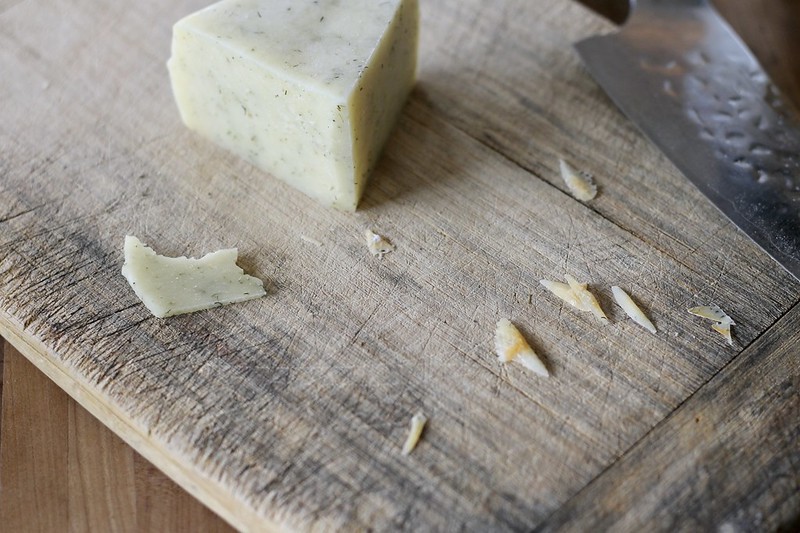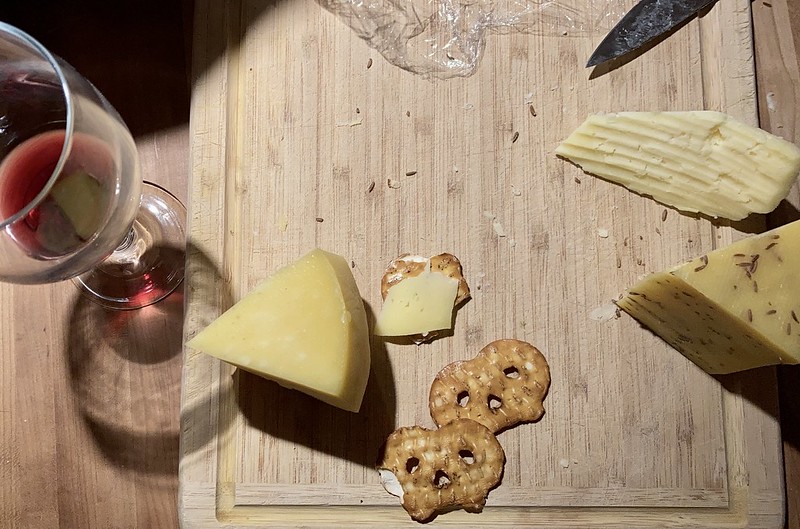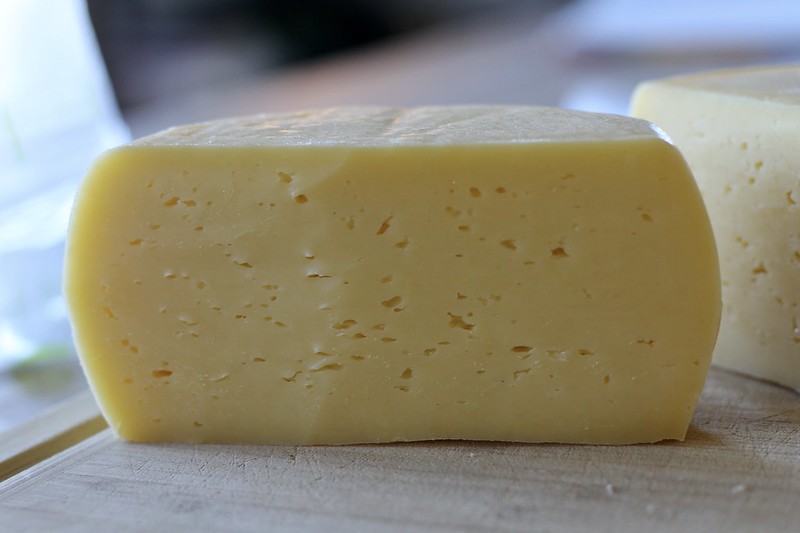After I screwed up my camemberts, I emailed a person who, I heard through another friend, makes white mold cheeses. I wondered if she might be willing to tell me about her process? She wrote back, How about we start a cheesemakers club? and the very next week, we held our first meeting. (I joked we should call ourselves “Blessed,” as in “blessed are the cheesemakers.”)

There are five of us — FIVE cheesemakers! what a wealth of resources! — but only three of us could make the first gathering. No matter. We talked fast and hard for over two hours and ate enough cheese for about a half dozen people: mozzarella, Colby, Caerphilly, Monterey Jack, ricotta, Gouda, year-and-a-half Asiago (which was delicious and tasted of … Time), and a couple marinated soft cheeses, plus some fails — rubbery jalapeño cheddar (mine) and bubbly feta (not mine) — because none of us are uppity and this is all about the learning. Also, there was wine and gingery lemonade and chutneys and crackers, etc.

Seeing the host’s cheesemaking operation was both fascinating and liberating. The differences between us — for cultures, she uses mostly kefir (rhymes with deer, I did not know this!) and yogurt and buttermilk, rather than freeze-dried powders; she lets her cheeses age in a wine fridge, uncovered and unwrapped, for months — were inspiring. I left feeling emboldened to trust myself more. People have been making cheese for years. This is not rocket science (though we all agree it is magic).

her mozzarella is incredible: buttery, and with the characteristic string cheese tear
Before I show you some of my recently-opened cheeses, a couple notes:
*I’ve noticed that our milk has changed flavor dramatically: almost all traces of farmyness— what I think of as that distinct raw-milk flavor— have vanished. We’re treating the milk the same, so my best guess is that it’s either because the weather is getting colder and the grass is changing, or because Daisy’s at a different point in her lactation. Or maybe both?
*And an update on the freeze-dried yogurt culture: The second batch of yogurt I made using culture from the first batch turned out perfectly fine. It may have been ever so slightly tangier, and maybe a touch looser, but it was hard to tell. So there you go!
Dill Havarti (Number 1)
This was my first cheese, made on Sunday, September 29. (To date, I’ve made 37 aged cheeses.) I forgot to let it set for forty-five minutes after adding the mesophilic culture, and I thought I might not have added enough salt, and it got bounced around a good bit, temperature-wise, since I was still in the middle of setting up my operation — aka The Murch Method: “Commit first, figure it out later” — but it turned out okay.

Not great, but passable: light, chewy, dilly, mild. There were bits of orange around the edges, but I shaved them off and there was no weird flavor.

It definitely needed more salt which makes me wonder: even though it’s already aged, could I soak the remaining cheese in a saturated salt brine for several hours, air dry, and repack?

My favorite way to eat this one is with crackers and chicken salad.
Stirred Curd with Jalapeño (Number 6)
For this cheese, I simmered 3-4 tablespoons of jalapeño in some water, added the water to the milk (three gallons) at the start of the process, and then added the cooked jalapeño when I added the salt, after milling the curds.

There was a distinct jalapeño flavor but hardly any heat, which was disappointing.

See those white streaks running down through the cheese? I have no idea what that’s about. Also, the texture was rubbery and chewy.

Before aging: do the bits of white curd signify anything, like they were too cooked?
It’s edible, but only just. What a bummer.
Caerphilly (Number 25)
Oh goodness, this one is good.

Caerphilly is a high-yielding, Welsh cheese; the recipe I used came from Gavin. The method is easy — a sort of cheater’s version of cheddaring in which the curds are cut into slabs and then briefly stacked on top of each other, and then there are a lot of rapid-fire rounds of pressing and turning during which the top and bottom gets salted repeatedly. The cheese only ages for three weeks which, in the world of cheesemaking, is no time at all.

The results are, as I already said, fabulous: salty and creamy, with a deliciously mild flavor and slight tang. My notes read: MAKE MORE!

clockwise from top: caerphilly, farmhouse caraway, butterkäse
When I pulled this out for a pre-supper snack, my husband couldn’t stop eating it, and for several days straight, I ate this cheese for lunch tucked into a leftover Magpie biscuit, with ham and mustard.

It doesn’t get much better than that.
Butterkäse (Number 19)
Again, this is one of Gavin’s recipes. I made it with four gallons of milk and a quart of cream, as is my custom since our milk is lower in fat. Partway through the aging process, my cheese developed little black spots on the top and bottom; they wouldn’t wash off, so I just let them be.

Turns out, they’re flavorless and no one died, so cool-cool. (And Gavin said— because, yes, I went to the top dog straightaway— those spots are actually brown and totally harmless.)

As for the cheese itself, my notes say, “Buttery, small holes, soft, delicious, soooo good!!! MAKE MORE.” So I guess I will.
Farmhouse Cheddar with Caraway (Number 20)
With the caraway, I followed the same process that I did with the jalapeño: cook the seeds in water, add the water to the milk in the beginning, and add the cooked caraway along with the salt.

the other cheese is butterkäse
The cheese was nice, mild and somewhat dry (firm?) with a distinct (and delicious) caraway flavor. (Again, I felt like the texture was ever so slightly on the side of rubbery. Not sure how to fix it…)

This makes a great snacking cheese. I kept thinking it’d go great with pretzels and apples and beer.
Derby (Number 15)
I made this British cheese (similar to cheddar, but easier) with the Jersey milk and the mesophilic whey leftover from making a gouda. It’s supposed to be aged for six months, but it can be eaten as early as four weeks. My notes say, “At first, farmy. On second thought, okay. Dry, lots of holes … actually quite good!”

But then when my husband tasted it, he was like, “That’s on the edge of off.” [eats more cheese] “Nope, that’s definitely off.” And it did taste off, I agreed, but it also tasted quite good. Or at least I thought so. The texture, anyway, is awesome. I had it today in a meatloaf sandwich. (Building it, I got a little carried away.)

But about this cheese: I think I need more opinions. Feel free to swing by and give it a taste!
Gouda (Number 7)
Rubbery (ARGH), with good, but mild, flavor.

Derby on the left
About this rubbery issue: what am I doing wrong? Best I can figure, it’s either because I’ve added too much rennet (but I really don’t think this is the case since I’m meticulous with measurements and most of the cheeses are not rubbery) or because I’m heating the curds too high or too fast or too something. But I’m temping and timing every step, and my notes don’t even make mention of any weird variations or screw-ups. So what’s going on?

a spot of harmless mold
Look at the Gouda (right) compared to the Derby (left):

They’re both made from three gallons of milk, but the Gouda is so small and tight. Grr. Is it because the Derby was made with the Jersey milk? Or because the Gouda’s curds were misheated somehow? The Derby might have a funk but at least it looks nice. Humph.
(I have several more Goudas aging right now. They feel quite different from this one— softer, fatter, more voluptuous— so maybe they’ll be better?)
This same time, years previous: change, sourdough English muffins, guayaba bars, success!, Thai chicken curry, the quotidian (11.16.15), the quotidian (11.17.14), lemony lentil goodness, so far so good.
7 Comments
Gavin Webber
Great looking cheese Jennifer! I love the idea of a cheese club, I wish had the time!
Katie P NC
I wish I hadn’t read this first thing in the morning because now I’ll be craving cheese all day at work. I also wish I lived near you (and knew you) so I could buy some of this delicious sounding cheese, I had no idea there were so many different kinds that I’d never heard of before.
Off to search for Caerphilly in Wilmington NC.
Becky R.
Oh, Jennifer, I wish I lived next door! I love this cheese adventure, and I would dive in, but there is only me and a husband with no appetite, so I fear I would die of eating cheese 7 days a week. HA! I would, however, love to make cheese with you and share the spoils. I bet you are overly critical of your cheeses. I have eaten lots of rubbery cheese, but it will be fascinating to find out what makes cheese rubbery. And I think if tasting critically, most cheese tastes “off” – it’s cheese! I am learning so much! Thanks for the yogurt culture update.
Sue
I just started subscribing to your blog and find it so interesting. Love your cheese making adventures!
Jennifer Jo
Welcome, Sue! It’s lovely to have you!
suburbancorrespondent
How do we know which molds are harmless and which aren’t?
Jennifer Jo
Well…. I’m not EXACTLY sure, but they say that the only really bad mold is the one that looks like black hair. Blue (green, gray, white) are either just fine, or they signify spoilage and can be scraped or washed off. Orange, red, pink aren’t great, and you probably don’t want to eat them, but they don’t sound deadly. Because I’m so cautious, I’m learning to let go a little and be kinda cool around molds. Still got a ways to go on that one, but growing my white mold camemberts (they look like fuzzy little animals!) is making me braver.